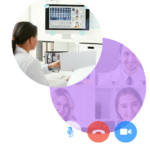Diabetes mellitus, a prevalent chronic condition, requires meticulous management. Telemedicine has revolutionized diabetes care by enhancing patient-provider interactions. This article examines the impact of telemedicine on:
- Continuous Glucose Monitoring (CGM)
- Remote Consultations
- Diabetes Management Applications
- Integrated Care Platforms
Introduction
Diabetes encompasses Type 1 (T1D) and Type 2 diabetes (T2D). Effective management traditionally requires frequent in-person visits. Telemedicine provides innovative solutions for remote monitoring and consultations, improving diabetes care.
Continuous Glucose Monitoring (CGM)
- Functionality: Uses a small sensor to continuously measure glucose levels.
- Real-Time Data: Enables immediate treatment adjustments.
- Benefits: Improved glycemic control and reduced HbA1c levels; fewer hypoglycemic and hyperglycemic episodes.
Remote Consultations
Telemedicine platforms facilitate remote consultations through video calls and secure messaging. This enhances accessibility, particularly for patients in rural areas. Evidence shows that remote consultations are as effective as in-person visits.
Diabetes Management Applications
Mobile apps help track blood glucose, medication adherence, and lifestyle factors. These tools enable patients to log and analyze their health metrics, with some offering personalized recommendations. Educational resources improve patient understanding and adherence.
Integrated Care Platforms
Integrated care platforms combine data from CGMs, insulin pumps, and electronic health records (EHRs) for comprehensive management. This integration promotes better coordination among healthcare providers and enhances collaboration among patients and care teams.
Conclusion
Telemedicine is transforming diabetes management through advanced tools like CGM, remote consultations, management apps, and integrated care platforms. As technology advances, telemedicine will play an essential role in providing effective and accessible diabetes care solutions.
Carepoi’s Commitment
At Carepoi, we are dedicated to integrating telemedicine into our diabetes management solutions. By leveraging innovative technologies, we empower patients to take control of their health and receive personalized care, ensuring better outcomes and enhanced quality of life.



